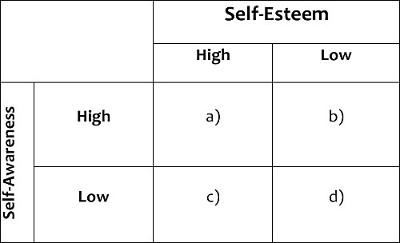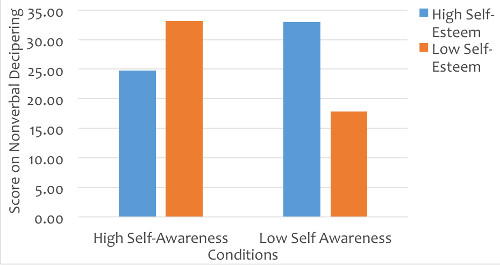The Factorial Experiment
Обзор
Source: Laboratories of Gary Lewandowski, Dave Strohmetz, and Natalie Ciarocco—Monmouth University
A factorial design is a common type of experiment where there are two or more independent variables. This video demonstrates a 2 x 2 factorial design used to explore how self-awareness and self-esteem may influence the ability to decipher nonverbal signals. This video leads students through the basics of a factorial design including, the nature of a factorial design and what distinguishes it from other designs, the benefits of factorial design, the importance and nature of interactions, main effect and interaction hypotheses, and how to conduct a factorial experiment.
Процедура
1. Introduction of topic/research question
- Research question: Human behavior is complex, such that a person’s thoughts and behaviors are the results of several causes or factors. For example, if you wanted to know why some people are better at reading another person’s facial expressions, there are many factors that can influence that ability.
- Justifying a factorial design: Rather than test potential explanations one at a time, you can use a factorial design, which is unique because it allows you to test two or more potential influences in the same study.
- Benefits of a factorial design: It saves time by testing causes simultaneously vs. sequentially. This allows the researcher to use fewer participants and reveals if the various causes combine in a special way to influence the outcome.
2. Key variables
- Variable = anything that changes in a study
- Independent variable = the cause or what the researcher manipulates/changes in order to detect changes in the participant
- Based on the researcher’s literature search, she believes that a person’s self-esteem (i.e., a person’s positive or negative evaluation of who they are as a person) and self-awareness (i.e., how conscious a person is about their own thoughts and feelings) are two independent variables to study
- Dependent variable = the effect or the outcome that the researcher measures in the participant
- Based on the research question, ability to accurately detect or decipher nonverbal communication is the dependent variable.
3. Research hypotheses
- Main effect hypotheses definition: Hypotheses in a factorial design that focus on one independent variable at a time, while ignoring any other independent variables
- Main effect 1: Those who experience high self-esteem will be more accurate judges of eye expressions than those who experience low self-esteem.
- Main effect 2: Those who experience high self-awareness will be more accurate judges of eye expressions than those who experience low self-awareness.
- Interaction hypothesis definition: A hypothesis predicting that one independent variable changes the other independent variable’s impact on the dependent variable
- Interaction: The impact of the self-esteem on the ability to accurately detect nonverbal communication will be enhanced for those who experience high self-awareness, but reduced for those how experience low self-awareness.
4. Defining the variables
- Self-esteem: To manipulate the independent variable of self-esteem, the researcher will provide participants with false-feedback regarding the participant’s ability to accurately name countries in Europe.
- Self-awareness: To manipulate the independent variable of self-awareness, place participants in front of a mirror. This is adapted from previous research.1
- Accuracy in decoding nonverbal communication: To measure the dependent variable of accuracy in decoding nonverbal communication, show participants several sets of eyes and ask them to identify the proper emotion being expressed. This is also an established test.2
5. Establishing conditions
- Self-Esteem: Ask participants to name as many countries in Europe as he or she could think of within 2 min. Provide feedback based on condition:
- For high self-esteem, participants learn that they scored in the top 10% and that their performances were “superior and above average.”
- For low self-esteem, participants learn that they scored in the bottom 50% and that their performances were “inferior and below average.”
- Self-awareness
- High = Sit participants in front of a mirror during the geography quiz (mirror should seem natural/inconspicuous as possible)
- Low = No mirror is present during geography quiz.
- Combinations of conditions: In a between subjects factorial design, each person gets one combination of the independent variables (Table 1). In this study, the four possible combinations are:
a) high self-esteem/high self-awareness
b) low self-esteem/high self-awareness
c) high self-esteem/low self-awareness
d) low self-esteem/low self-awareness

Table 1. Factorial Design. Shown are the possible combinations of factors for a 2 x 2 design.
6. Measuring the dependent variable (accuracy in decoding nonverbal communication)
- Quiz
- Have participants complete the quiz; make sure to mouse over pictures during the presentation to show eyes more clearly.
- Score = total number correct, which will result in a 0-36 score
7. Conducting the study
- Setting = research lab with a computer and space for a person to sit in front of mirror
- Informed consent
- In a research lab, meet participant for study on “The Faces of Culture.”
- Go through informed consent: “As you’ll read in the informed consent, this study is about perceptions of nonverbal communication and cultural knowledge. The purpose of this research is to learn how people interpret facial expressions. You’ll also read about any risks/benefits of participation, and that you are free to quit at any time”.
- Random assignment to condition
- Randomly order the packets with the participant’s combination of conditions (high self-esteem/high self-awareness; low self-esteem/high self-awareness; high self-esteem/low self-awareness; low self-esteem/low self-awareness)
- Running the study
- Self-awareness
- Depending on the condition, the participant will sit in front of mirror or not.
- Self-esteem
- Give participants a sheet with 50 spaces on it and ask them to list as many countries in Europe as they can in the next 2 min. Start timer. After analyzing the participants results compared to past participants, provide feedback (based on condition) on a sheet of paper
- Rating attractiveness of pictures
- Sits participants in front of a computer to take the online version of an online quiz (http://www.questionwritertracker.com/quiz/61/Z4MK3TKB.html). The quiz asks “For each pair of eyes, choose which word best describes what the person in the picture is thinking or feeling.” Score how many each person gets right out of 36.
- Self-awareness
- Debriefing
- Explain the purpose of the study to the participant. Read from debriefing sheet: “Thank you for participating. Our study was on the effects of self-esteem and self-awareness on how people perceive ambiguous facial expressions. We hypothesized that people with low self-esteem and low self-awareness would interpret facial expressions as more judgmental and aggressive than others with high self-esteem and high self-awareness. Do you have any questions?”
- Address deception.
- Explain: “It is important that we get a natural performance, not one that the participant feels is expected. If participants were to know the true reasoning and hypothesis behind the study they may perform in an unnatural way by trying to live up to the experimenters perceived expectations. To eliminate this problem it is necessary for the experimenter to provide the participant with false information. In this experiment, we did this by providing you with false feedback of the geography quiz you took. In actuality, we did not score the quiz in any way. The feedback you received was based on random assignment and is in no way a true indication of your abilities. This was necessary so that we could be sure everyone would experience a short boost or drop in self-esteem. Because of the nature of how we did the study, it is quite natural for participants to have believed the feedback, but rest assured that it was not real.”
Результаты
After collecting data from 136 people, a two-way analysis of variance (ANOVA) was performed to test the two main effects and interactions. As shown in Figure 1, contrary to the hypothesized pattern, when participants had high self-awareness, they were more accurate when they had low self-esteem; however, when they had low self-awareness, they were more accurate when they had high self-esteem.
Beyond their influence on deciphering the meaning in a person’s eyes, greater self-awareness can lead those with low self-esteem to experience more negative emotions such as feeling depressed.
If researchers can identify factors that cause greater accuracy in understanding non-verbal communication, it is possible that individuals can learn how to read other’s nonverbal signals better. Think of all of the contexts where being able to accurately understand a person’s expressions would help. Working in sales, playing sports, interviewing job candidates, and going on dates. Really, nonverbal communication is everywhere and figuring out ways to read it more accurately can only help.

Figure 1. Nonverbal communication deciphering by self-esteem and self-awareness. Shown are the mean scores across conditions.
Заявка и Краткое содержание
A factorial design is commonly used in psychology experiments. This design is beneficial for a variety of topics, ranging from pharmacological influences on fear responses to the interactions of varying levels of stress and types of exercise.
Ссылки
- Wicklund, R. A., & Duval, T. S. Opinion change and performance facilitation as a result of objective self-awareness. Journal of Experimental Social Psychology. 7, 319-342 (1971).
- Baron-Cohen, S., Wheelwright, S., Hill, J., Raste, Y., & Plumb, I. The 'Reading the mind in the eyes' Test revised version: A study with normal adults, and adults with Asperger syndrome or high-functioning autism. Journal of Child Psychology and Psychiatry. 42 (2), 241-251. doi:10.1111/1469-7610.00715 (2001).
Перейти к...
Видео из этой коллекции:

Now Playing
The Factorial Experiment
Experimental Psychology
73.2K Просмотры

From Theory to Design: The Role of Creativity in Designing Experiments
Experimental Psychology
18.6K Просмотры

Ethics in Psychology Research
Experimental Psychology
29.1K Просмотры

Realism in Experimentation
Experimental Psychology
8.3K Просмотры

Perspectives on Experimental Psychology
Experimental Psychology
5.7K Просмотры

Pilot Testing
Experimental Psychology
10.3K Просмотры

Observational Research
Experimental Psychology
13.1K Просмотры

The Simple Experiment: Two-group Design
Experimental Psychology
74.3K Просмотры

The Multi-group Experiment
Experimental Psychology
22.8K Просмотры

Within-subjects Repeated-measures Design
Experimental Psychology
23.1K Просмотры

Self-report vs. Behavioral Measures of Recycling
Experimental Psychology
11.8K Просмотры

Reliability in Psychology Experiments
Experimental Psychology
8.5K Просмотры

Placebos in Research
Experimental Psychology
11.6K Просмотры

Manipulating an Independent Variable through Embodiment
Experimental Psychology
8.5K Просмотры

Experimentation using a Confederate
Experimental Psychology
17.8K Просмотры
Авторские права © 2025 MyJoVE Corporation. Все права защищены